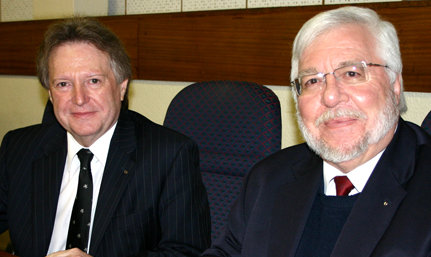|

|
Prof. Johann Henning, Dean of our Faculty of Law and Prof. Barry Rider.
Photo: Leonie Bolleurs |
Prof. Barry Rider, respected amongst others for the vital role he is playing in the struggle to combat money laundering and organised and economic crime delivered a lecture, Stewardship in Islamic Financial Law, at our university as part of the Faculty of Law’s Prestige Series of seminars.
He has taught mainly at Cambridge and London Universities and has delivered a valuable contribution as an academic in various fields of law. He has read papers and taught at more than 300 universities and conferences in more than 63 countries. He has also authored more than 35 legal handbooks and has made a substantial contribution to several more specialist publications. He is editor of, amongst others, The Company Lawyer, the International and Comparative Corporate Law Journal and the Journal of Financial Crime. His main areas of research are in financial law and the control of economic crime.
Prof. Rider has a relationship of more than twenty years with our university. In this time, he received the Doctor Legum (honoris causa) for his involvement with the drafting of money laundering and insider trading legislation. The university has also appointed him as Professor Honorarius in the Faculty of Law (only the second in its more than hundred-year history) for his vast and pivotal role in international law reform as an academic law reformer.
As part of his appointment as Honorary Professor in the Faculty of Law, Prof. Rider often delivers lectures in the faculty. During his recent visit, Prof. Rider’s lecture on Islamic Financial Law shed light on the importance of this topic in today’s economy, as money generated from Islamic businesses make up $750 billion to $trillion of the world’s economy. After 9/11, the West wanted to understand more about Islamic Financial Law.
The Islamic Financial Law system is determined by the Koran. For instance, Muslim business people cannot allow any payment of interest, as it is forbidden by the Koran.
Prof. Rider’s lecture on this very relevant topic was very insightful. As consultant to the Islamic Financial Services Board (IFSB) he spoke with authority on the topic. He is the only British academic lawyer assisting this body.
Prof. Rider currently serves in an advisory capacity at the international law firm Bryan Cave LLP. Apart from the IFSB, he is also consultant to the Asian Development Bank.